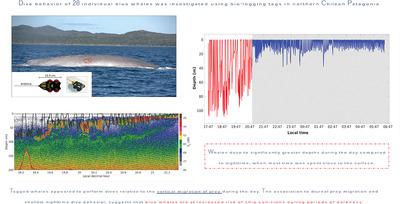当前位置:
X-MOL 学术
›
Integr. Zool.
›
论文详情
Our official English website, www.x-mol.net, welcomes your
feedback! (Note: you will need to create a separate account there.)
Diel differences in blue whale (Balaenoptera musculus) dive behavior increase nighttime risk of ship strikes in northern Chilean Patagonia
Integrative Zoology ( IF 3.5 ) Pub Date : 2020-11-09 , DOI: 10.1111/1749-4877.12501 Francesco Caruso 1, 2 , Leigh Hickmott 3, 4 , Joseph D Warren 5 , Paolo Segre 6 , Gustavo Chiang 7 , Paulina Bahamonde 7, 8 , Sonia Español-Jiménez 7 , Songhai Li 1 , Alessandro Bocconcelli 2
Integrative Zoology ( IF 3.5 ) Pub Date : 2020-11-09 , DOI: 10.1111/1749-4877.12501 Francesco Caruso 1, 2 , Leigh Hickmott 3, 4 , Joseph D Warren 5 , Paolo Segre 6 , Gustavo Chiang 7 , Paulina Bahamonde 7, 8 , Sonia Español-Jiménez 7 , Songhai Li 1 , Alessandro Bocconcelli 2
Affiliation

|
The northern Chilean Patagonia region is a key feeding ground and a nursing habitat in the southern hemisphere for blue whales (Balaenoptera musculus). From 2014 to 2019, during 6 separate research cruises, the dive behavior of 28 individual blue whales was investigated using bio-logging tags (DTAGs), generating ≈190 h of data. Whales dove to significantly greater depths during the day compared to nighttime (day: 32.6 ± 18.7 m; night: 6.2 ± 2.7 m; P < 0.01). During the night, most time was spent close to the surface (86% ± 9.4%; P < 0.01) and at depths of less than 12 m. From 2016 to 2019, active acoustics (scientific echosounders) were used to record prey (euphausiids) density and distribution simultaneously with whale diving data. Tagged whales appeared to perform dives relative to the vertical migration of prey during the day. The association between diurnal prey migration and shallow nighttime dive behavior suggests that blue whales are at increased risk of ship collisions during periods of darkness since the estimated maximum ship draft of vessels operating in the region is also ≈12 m. In recent decades, northern Chilean Patagonia has seen a large increase in marine traffic due to a boom in salmon aquaculture and the passenger ship industry. Vessel strike risks for large whales are likely underestimated in this region. Results reported in this study may be valuable for policy and mitigation decisions regarding conservation of the endangered blue whale.
中文翻译:

蓝鲸(Balaenoptera musculus)潜水行为的差异增加了智利北部巴塔哥尼亚夜间船舶撞击的风险
智利北部巴塔哥尼亚地区是南半球蓝鲸(Balaenoptera musculus)的主要觅食地和哺乳栖息地。从 2014 年到 2019 年,在 6 次单独的研究巡航中,使用生物记录标签 (DTAG) 研究了 28 头蓝鲸个体的潜水行为,产生了约 190 小时的数据。与夜间相比,鲸鱼在白天潜入更大的深度(白天:32.6 ± 18.7 m;夜晚:6.2 ± 2.7 m;P < 0.01)。在夜间,大部分时间都在靠近地表的地方度过(86% ± 9.4%;P< 0.01) 且深度小于 12 m。从 2016 年到 2019 年,主动声学(科学回声测深仪)被用来与鲸鱼潜水数据同时记录猎物(euphausiids)的密度和分布。标记的鲸鱼似乎在白天进行相对于猎物垂直迁移的潜水。昼夜猎物迁徙与夜间浅层潜水行为之间的关联表明,蓝鲸在黑暗期间发生船舶碰撞的风险增加,因为在该地区作业的船舶的估计最大船舶吃水也约为 12 m。近几十年来,由于鲑鱼养殖业和客船业的蓬勃发展,智利北部巴塔哥尼亚的海上交通大幅增加。在该地区,大型鲸鱼的船舶撞击风险可能被低估了。
更新日期:2020-11-09
中文翻译:

蓝鲸(Balaenoptera musculus)潜水行为的差异增加了智利北部巴塔哥尼亚夜间船舶撞击的风险
智利北部巴塔哥尼亚地区是南半球蓝鲸(Balaenoptera musculus)的主要觅食地和哺乳栖息地。从 2014 年到 2019 年,在 6 次单独的研究巡航中,使用生物记录标签 (DTAG) 研究了 28 头蓝鲸个体的潜水行为,产生了约 190 小时的数据。与夜间相比,鲸鱼在白天潜入更大的深度(白天:32.6 ± 18.7 m;夜晚:6.2 ± 2.7 m;P < 0.01)。在夜间,大部分时间都在靠近地表的地方度过(86% ± 9.4%;P< 0.01) 且深度小于 12 m。从 2016 年到 2019 年,主动声学(科学回声测深仪)被用来与鲸鱼潜水数据同时记录猎物(euphausiids)的密度和分布。标记的鲸鱼似乎在白天进行相对于猎物垂直迁移的潜水。昼夜猎物迁徙与夜间浅层潜水行为之间的关联表明,蓝鲸在黑暗期间发生船舶碰撞的风险增加,因为在该地区作业的船舶的估计最大船舶吃水也约为 12 m。近几十年来,由于鲑鱼养殖业和客船业的蓬勃发展,智利北部巴塔哥尼亚的海上交通大幅增加。在该地区,大型鲸鱼的船舶撞击风险可能被低估了。











































 京公网安备 11010802027423号
京公网安备 11010802027423号